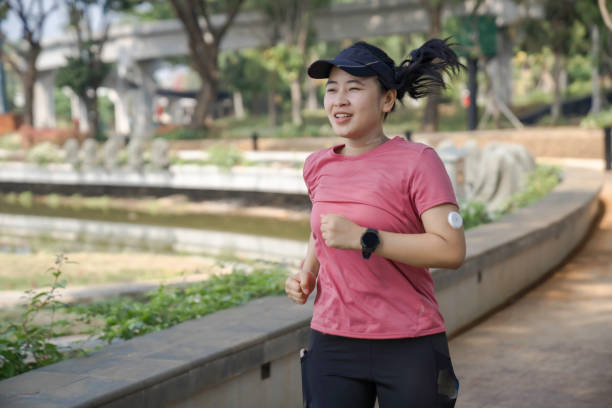.jpg)
Type 1 Diabetes
It occurs when the body produces insufficient quantities of insulin. It is usually detected more in children. Type 2 diabetes occurs when the body does not effectively use the insulin it produces. This is due to a lack of physical activity, obesity, and incorrect dietary habits. Gestational diabetes occurs among pregnant women. In about 90 percent of cases, it is type 2 diabetes that people are suffering from. The occurrence of type 2 diabetes (Diabetes Mellitus) may be prevented or reversed by adopting a healthy eating lifestyle.

Type 2 Diabetics
Blood sugar is a symptom of the underlying problem of insulin resistance and carbohydrate intolerance, so when we manage diabetes by indirectly reducing blood sugar with either medicines or insulin, we are only treating the symptoms of the disease and not addressing the root cause.
The big question is: is diabetes a disease? No, it's not. I will explain to you how. Now, understand this. As it is not a disease, it cannot be cured with medicine. Diabetes is a nutritional disorder that can only be treated with the right knowledge of nutrition if you are open to learning the basics of nutrition science.
Today's diabetes treatment is more focused on management than reversal. Today, we will help you understand the why and how behind type 2 diabetes.

How Food Affects Blood Sugar
What happens when we eat Carbohydrates, Protein, and Fat?
Your blood insulin responds very differently to different macronutrients. Fat does not impact blood insulin levels. Carbs have a high impact, and protein impacts them moderately, but fat has no impact.
Carbs and fats can both provide energy for the body—but not at the same time. When carbs are abundant in the diet, carbs function as the preferred fuel source. But when carbs are limited in the diet, fat becomes the preferred fuel source.
When you reduce your intake of one macronutrient, you have to increase your intake of at least one other macronutrient to avoid feeling hungry and not having enough energy.
In a low-carb, high-fat diet, fat provides you with the energy your body needs, and it also reduces hunger and cravings.

Carbohydrate Intolerance and Insulin Resistance
Type 2 diabetes is a disease of high blood sugar. It can also be thought of as carbohydrate intolerance or insulin resistance. That means when someone with type 2 diabetes eats carbohydrates, it causes their blood sugar to rise above a healthy level.
Everyone has a different carbohydrate tolerance. One person may be able to eat a carb-heavy diet with no problem, and another may get blood sugar spikes and gain weight from eating very few carbohydrates. Both people can be healthy, as long as they are eating within their tolerance levels.
What is a Carbohydrate?
It’s one of the main energy sources in many foods, including bread, pasta, fruit, and starches. When carbohydrates are digested, they are broken down into glucose in the blood. You may know this as blood sugar.
But it’s important to know, how much sugar is required by our body.
An adult body, on average, has 5 liters of blood. A healthy body always tries to maintain a blood sugar level of 100 mg/dl. What do these numbers tell you? 100 mg/dl comes out to be 1 g per 1 liter of blood, which is 5 g per 5 liters of blood. What is the minimum safe level of blood sugar a healthy person can achieve in fasting conditions? It's 70mg/dl. That’s 3.5 grams per 5 liters. So for optimum brain function, the minimum amount of sugar (glucose) that is required by the body is just 3.5 mg, way less than a teaspoon (~5 g).
But how much sugar do we eat on a daily basis? Let’s ask ourselves and do a self-check. The below infographics will help you do that. The body allows for only 1 teaspoon of sugar per 5 liters of blood, but there are 9 teaspoons in a cup of cooked white rice.
The excess glucose in your blood is pulled out by the hormone insulin. For a person with a high carbohydrate tolerance, this process works well, and excess blood sugar is promptly removed.
In a person with carbohydrate intolerance, type 2 diabetes, or prediabetes, this system breaks down. The body loses its insulin sensitivity, and more and more insulin is required to remove the excess blood sugar. As a result, blood sugar levels remain high and insulin levels are high as well, and these high insulin levels can make your body even less sensitive to insulin.
The result? The cycle will happen over and over again, and the problem will get worse.
How Type 2 Diabetes Became an Epidemic
Have you heard about a 1958 study named “Seven Country Study” by Ancel Keys? If not, I will urge you to do a Google search and do some research to find out more about this. Ancel Keys's seven-country study gave us this new food pyramid in the 1970s.
The food pyramid recommended 6–11 servings of carbs per day and very little fat—a typical very low-fat and very high-carb diet. As we discussed earlier, type 2 diabetes is a disease of carbohydrate intolerance. Someone with type 2 diabetes or prediabetes has a low carbohydrate tolerance, so eating carbs will lead to exaggerated blood sugar spikes. While those with a high carb tolerance may be able to eat a carb-heavy diet and remain healthy, someone with a low carb tolerance will experience chronic high blood sugar and likely even weight gain if they eat a high-carb diet.

Soon after these guidelines were recommended in 1977, type 2 diabetes prevalence increased dramatically, and it hasn’t slowed down since. These dietary recommendations have made high-carb, low-fat foods a staple across the globe, including India. Under the fear-psychosis, diary Ghee, butter, cheese, and coconut oil consumption were replaced with unhealthy hydrogenated industrial oils (which are loaded with trans-fat), and in the name of "healthy," sugar-laden and low-fat processed grains flooded the market. The so-called healthy diet began to include more sugary and processed flour as well as more processed grains. Since all carbohydrates (even complex carbs) are broken down into sugar in the body, these dietary recommendations meant that the average blood sugar of sedentary humans began to rise, and the diabetes epidemic began to grow.
Why ‘Eat less, Exercise More’ doesn’t Work
With the explosion of type 2 diabetes, there has also been an explosion in the treatments offered. Many new drugs have been brought to market, and there are hundreds of lifestyle interventions to choose from.
The problem with a medication-based approach is that you’ll most likely have to be on these medications for the rest of your life. They are expensive, and many come with a host of side effects. The medication approach focuses on the management of diabetes, not reversal. Taking medications for type 2 diabetes combats the result, which is rising blood sugar, but does not address the root causes—insulin resistance and carbohydrate intolerance.
Shifting the paradigm to diabetes reversal, however, means addressing the root causes of type 2 diabetes.

Most lifestyle interventions focus on eating less and exercising more. I am pretty sure many of you must have followed this advice. Are you getting any better? Did you manage to stop your diabetes medicine? And are you able to maintain your HbA1c below 5? And then, the most important thing is that you just cannot stay hungry most of the time.
The problem with these programs is that they tend to be high in carbs, even if they are cutting back on calories. When you eat a high-carb diet, the resulting increase in your blood sugar triggers an insulin response in your body, and insulin blocks your body’s ability to burn fat.
Insulin actively blocks the breakdown of stored body fat, meaning that as long as insulin is high, it will be very difficult to lose weight, even if you are eating very little.
When you eat too few calories, you typically feel exhausted and experience hunger and cravings. However, a low-carb, high-fat diet can help keep your blood sugar and insulin levels down. It may seem counterintuitive, but to lose fat, you have to eat fat. This way of eating is called the low-carb, healthy fat, or LCHF way of eating.
LCHF and Diabetes Reversal
Before this, we need to understand the problem with the current approach to diabetes treatment in a little more detail. The current approach is all about diabetes management and works on three lies.
- It is a progressive disease
- Treat the sugar
- Control the sugar with medicine
Any disease (in this case, diabetes) is your body’s intelligent response to a perceived threat. This threat can be physical, chemical, or emotional. In this case, increased blood sugar is a response to a threat. We try to suppress the blood sugar with chemicals, but the body responds to our abuse and neglect (by the food we feed it) by further increasing blood sugar levels.
Conventional treatment is oriented toward blood sugar, whereas the real culprit is insulin resistance. In the case of diabetes, insulin resistance is the disease; blood sugar is only the symptom. And the medication or insulin shots are just to suppress or manage the symptoms. Therefore, it cannot cure or reverse diabetes.

2 Approaches
Approach 1 – Treat the Symptom
If you aim to treat the sugar, the only treatment is medicines – tablets or medicines or both. And maybe at a later stage insulin injections…. More, more & more……
Approach 2 – Treat the Root Cause
If you aim to treat insulin resistance, the only treatment is diet.
In approach 1, by giving medicines to the patient, the blood sugar will come down for some time, then it will go up again. Medicine is attached to money. The manufacturing and selling of medicines make money. In approach 2, the blood insulin and the blood sugar come down and stay down. There is no money involved. Now you may be able to understand why the conventional treatment of diabetes has taken approach 1.
The right approach to treating diabetes should be approach 2.
Type 2 diabetes is a dietary disorder, it should not be treated with medicines; it should be treated by changing the way of eating. The culprit of diabetes is insulin resistance.
The Problem – High Level of Insulin
The Solution – Eat Food that does not Stimulate Insulin.
Conventional treatment of diabetes is similar to pinching the baby and rocking the cradle—advising a diet that increases your blood sugar and prescribing medicines or insulin that bring the blood sugar down.
The science is simple. The journey may be a little longer and more difficult. But just like a rocket uses boosters to escape the force of gravity on the earth, we need to empower ourselves with knowledge and launch out of the faulty beliefs that are holding us down. Once we launch out, we’ll be in a different zone.


.png)


